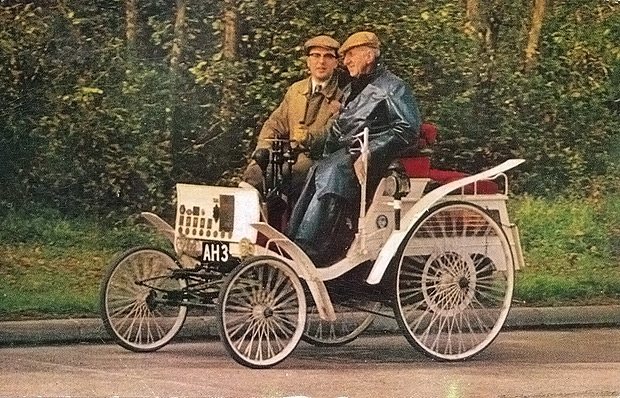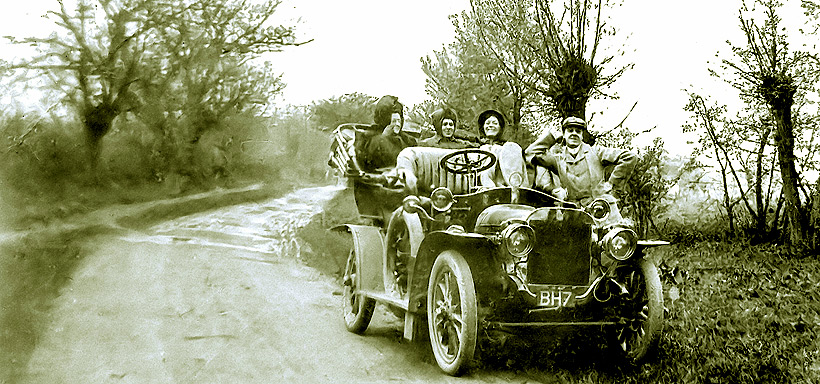|
Screen-grab taken from a British silent short film "How to stop a
Motor Car" made in 1902 where cars are being investigated by IMCDB.
Story is a silent Hepworth comedy at the expense of how a police officer
could stop a car 'racing' along the road. Very early use of stop motion
trick photography where the policeman, the passengers and the car explode
un big puffs of smoke, bits of limbs flying everywhere. The car in all
three photos is the same cca 1898 Benz Velocipede
'Velocipede' was a
vehicle manufactured by Rheinishe Gasmotorenfabrik Benz
& Cie in Mannheim, introduced in 1894, and was Karl Benz's second production car after the 'Patent
Motorwagen'. Vehicle was powered by a
1,045cc single cylinder engine initially producing 1.5HP, which was later
increased to 3HP. It was the world's first serial production car, 67
having been built in the first year and 134 the second. In 1984 Benz
introduced an additional two seater faster version of the Velo named the
Viktoria, and in 1898 a more luxurious version of the Velo appeared, named
the 'Comfortable'. The 'Comfortable' can be recognised by having a higher
dashboard than the one in the above picure. By 1902, when the new 'Persifal'
range of Benz vehicles was introduced, over 1,200 Benz Velo type vehicles
had been produced.
|
  |
|
The Velocipede gives the impression of
being a two-seater vehicle but photo right below show four people in the car.
Our Ariejan Bos advised that the Velocioede could easily be changed into a
dogcart by placing a simple seat on top of the rear engine compartment so that
the rear passengers sat back to back (dos-à-dos) to the driver. A foot
support, held by chains, would keep the passenger from falling off. On the
photo with the four people in the Benz (below right), the man in the back seat
is clearly turning his head to look forward. The photo above shows the
optional rear dos-a-dos seat in position, and also shows the very much
lower-down mounted and smaller dash board of earlier Velocipedes..
|
 |
The Benz Velocipede vehicle (above) appeared in a two minute film made by the Hepworth
Manufacturing Company in 1902 called 'How To Stop A Motor Car'. We have
already investigated a number of cars used in early Hepworth films and our
article on "The Dog Outwits the Kidnapper"
(1908), defines early Hepworth film history. Originally we had an enquiry to name the car in
Cecil Hepworth's 1907 film 'Rover drives a car' where a dog looking very
much like, but preceding 'Lassie', rescues a child. While on the subject
of Lassie, a Rough Coated Collie, it may be interesting to note the
original Lassie was a British story. The later story that we we all know
from the cinema was by
Eric Knight, later made into a MGM movie. Lassie was actually a laddie called
Pal, and his trademarked descendants continue to play the part. In that
Hepworth film the car was a 1907 Riley 9HP and the dog's actual name was
'Blair'. The dog was Hepworth's. and it was the first cinema animal to have named
role.
|
 |
Subsequent two film 'shorts' featuring Rover are frequently mixed up.
One is "Cecil Hepworth's "Rescued by Rover", a six minute
film issued in 1905. No motor vehicles involved in the plot. Interesting
to note that the film helped to install Rover as nation's favorite name
for a dog. The child was Hepworth's daughter Barbara. Cecil Hepworth
made a second 'Rover' film titled "The Dog Outwits the
Kidnapper" which was eight minutes long and was made in 1908. A
kidnapper in a car steals the baby, Rover chases car for miles, and Rover
then drives the car back with baby still in it. The child is Hepworth's
daughter Barbara, Mother is Hepworth's wife, and Hepworth is Father. Early
films were made in Walton-on-Thames. In the earlier 1902 film "How to
stop a Motor Car" it was Cecil Hepworth's father Thomas, who was the
primary actor as the longsuffering policeman. It should be noted that dad Thomas
Hepworth had previously been a very famous 'lanternist' during the late
1800 when painted slides and silhouette shadows pre-dated films and which were the only means of
lantern projection.
Carrying on the family business, son Cecil Hepworth had become an early
cine pioneer, and had
established a film-printing laboratory at Walton-Thames in 1896. He had
also begun producing and distributing films. It is also interesting that this much earlier 1902 film
"How to stop a Motor Car" was made by the
'Hepworth Manufacturing Company which had been established by "film director
and producer Cecil Milton Hepworth (1874-1953)". Founded in 1903 as 'Hepworth
& Co', registered as Hepworth Manufacturing Company, with trademark
Hepwix, it became 'Hepworth Picture Plays' in 1919. Initially quite successful,
the company attempted
to expand after the First World War, but in 1923 went into liquidation. Cecil Hepworth retired from filmmaking. The studios were sold off and
were later used by other film producers.
|
|
We have also had
further enquiries on a different later car belonging to Cecil Hepworth
which probably dates to about 1910 when he owned a Scottish made cca 1910
Argyll 16’20. A Separate Help Page
is devoted to Hepworth's Argyll
registration BH7.
BH7 is however, not the registration that ties in with the age of the car
nor was it issued to this make. BH7 was issued at the turn of 1903 by
Buckingham County Council, - and not to Hepworth, - but to 1903 5.5HP
Oldsmobile Runabout.
|

|
|
Help Pages dealing with this
subject:
Help
Page 33
Help
Page 174
Help
Page 187
Help
Page 204
|
Go to Recent Venues Page
PICTURE GALLERY INDEX
|